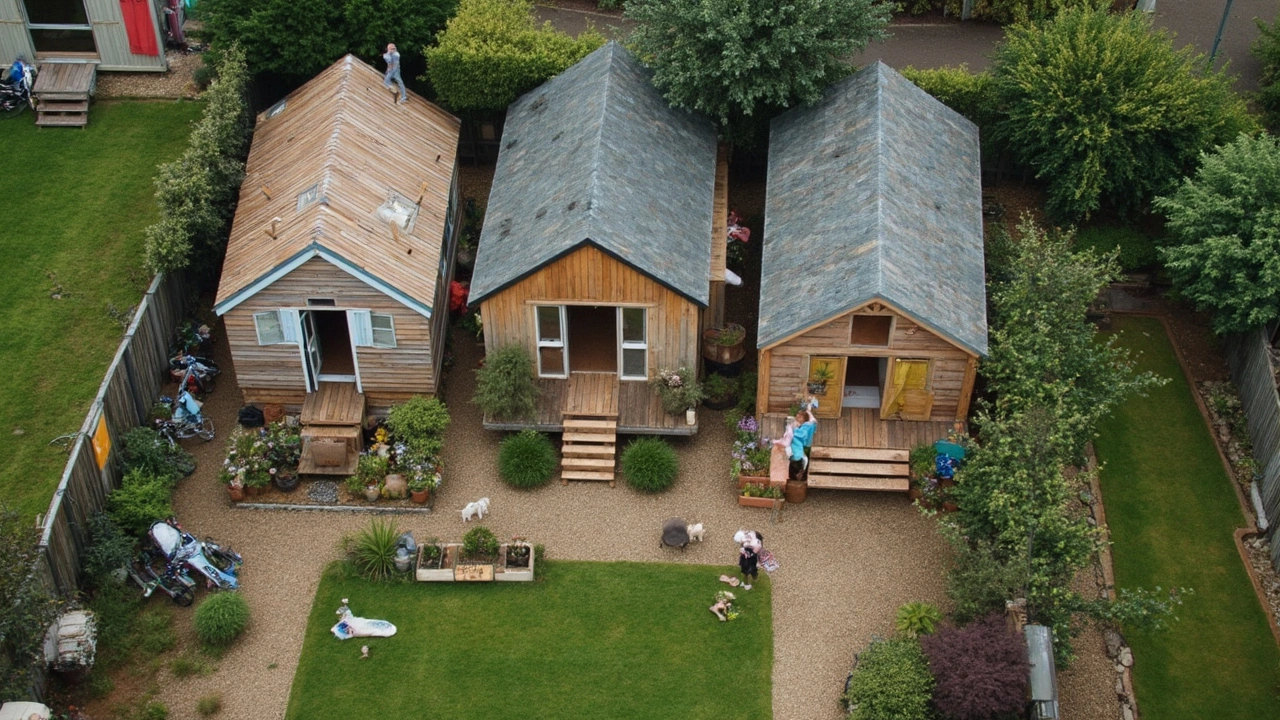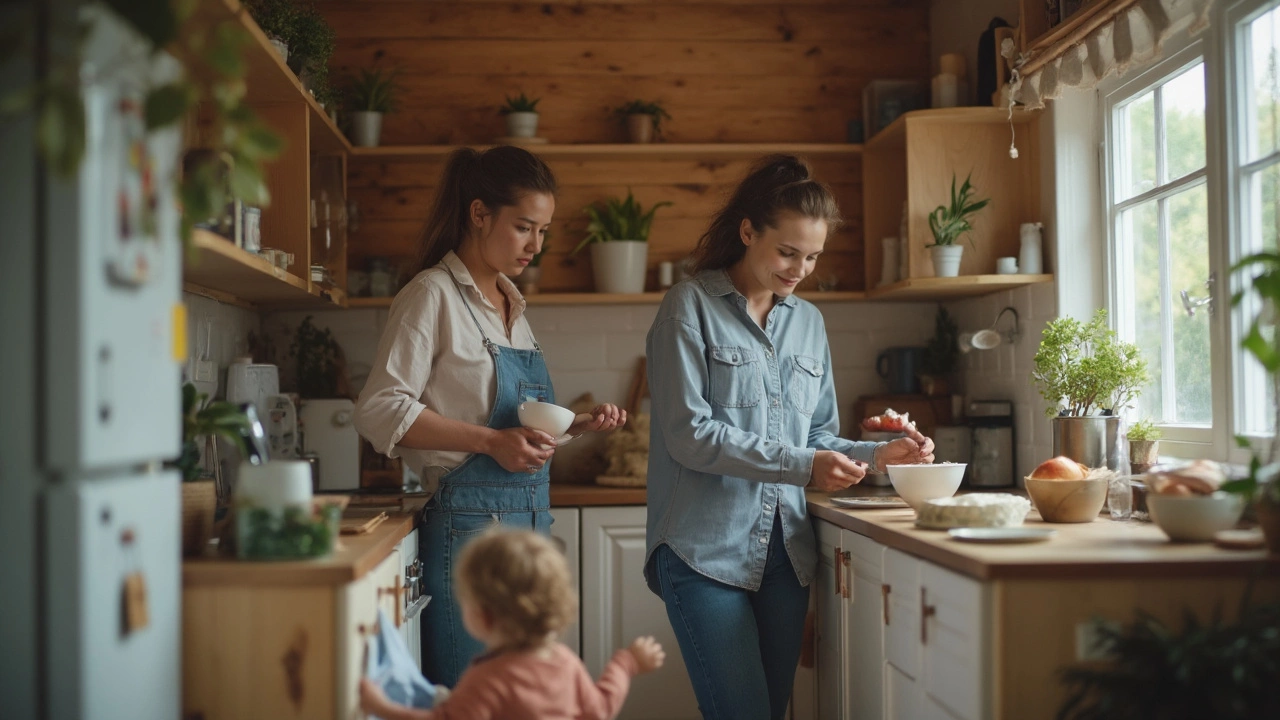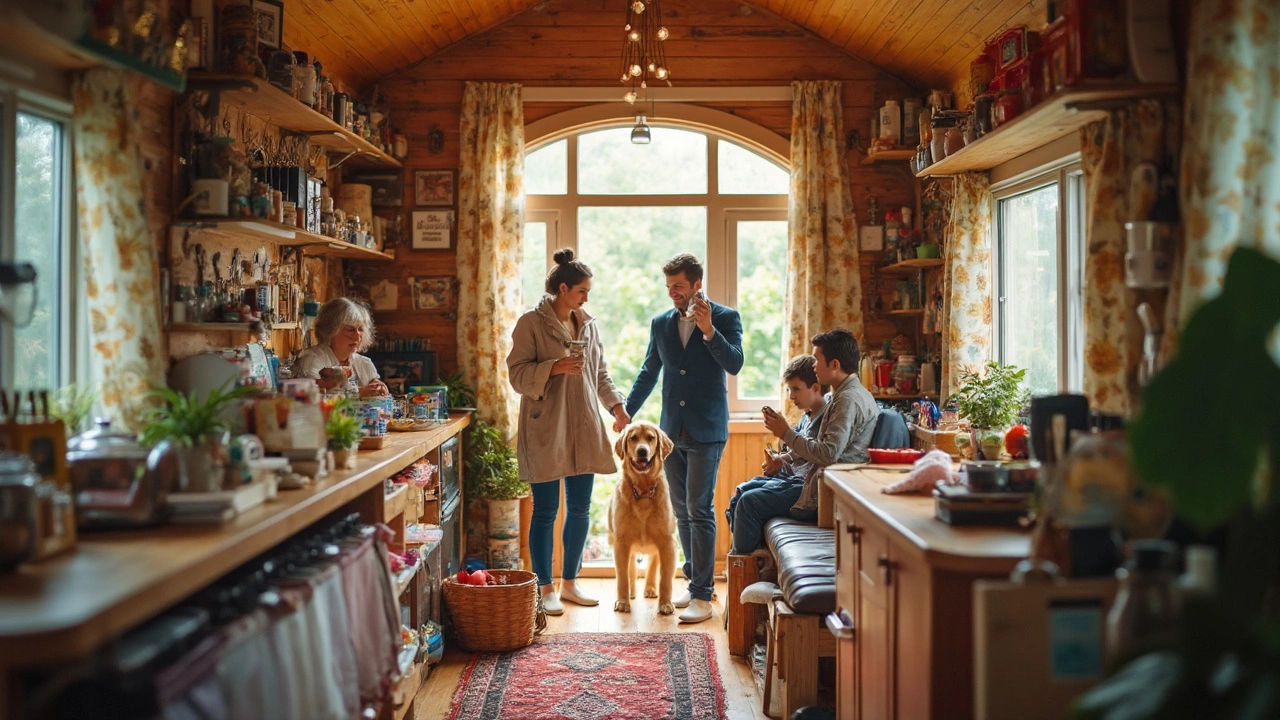If you think living in a tiny house is all cozy mornings and Instagram vibes, reality might hit harder than you expect. The eco-friendly part is great—fewer lights to turn off, less heat to waste, smaller bills. But squeezing your life into 200 square feet? That’s a different story, especially once you add in kids, hobbies, or even just a week’s worth of groceries.
The most obvious thing you’ll notice is how little room you actually have for, well, everything. Even with clever shelves, hidden drawers, and furniture that doubles as storage, you’re always making decisions about what stays and what has to go. If you love holding onto books, kitchen gadgets, or your kid’s endless crafts, get ready for some tough choices. And yes, everyone can hear your phone call—or your meltdown—so privacy becomes a rare luxury.
- Cramped Space and Privacy Struggles
- Storage Solutions (and Their Limits)
- Family Dynamics in Tight Quarters
- Dealing with the Unexpected (Plumbing, Permits, Weather)
- Tips to Make Tiny Living Easier
Cramped Space and Privacy Struggles
Let’s be real—personal space in a tiny house is more of a wish than a fact. The average tiny home in the U.S. clocks in at about 225 square feet, which is smaller than most studio apartments. Sounds cute until you realize that fits a bed, a small couch, kitchen basics, and usually not much more. Privacy? Pretty much whatever room you’re in, you’re sharing. Even the bathroom doors in some designs are sliding barn doors, not exactly soundproof. Zinnia and I can barely have a serious chat without the entire house knowing what’s up.
One big problem is noise—everyone notices every little sound. I’ve learned that late-night phone calls or sneaking out for snacks are just not private. And sharing a space with pets or kids? Their stuff ends up everywhere, so boundaries blur fast.
| Comparison | Tiny House | Standard Apartment |
|---|---|---|
| Average Size (sq ft) | 225 | 900 |
| # of Enclosed Rooms | 1 | 3-5 |
| Dedicated Work Area | No | Usually yes |
| Level of Privacy | Low | Medium-High |
No matter how you arrange things, squeezing into a tiny footprint means people are practically always in each other’s space. Changing clothes, needing a silent moment, or even just zoning out feels like a group activity. And if you work from home, get ready to share your video calls with background chaos.
- Loft beds can create a little separation, if you don’t mind climbing.
- Sound machines or headphones help block some noise—but not all.
- Many families set up “quiet hours” just to stay sane.
So, if you value your alone time, keep in mind that tiny house living pretty much guarantees a lot of togetherness, whether you’re in the mood for it or not.
Storage Solutions (and Their Limits)
One of the first things that trips people up in a tiny house is storage. You can get super creative with space-saving tricks, but there’s always a hard cap on how much you can actually stash away. Even the smartest designs—like under-bed drawers, pull-out pantries, and built-in benches—will only get you so far. Most tiny houses hover around 150 to 400 square feet, so every single item has to earn its keep.
Here’s what tends to work:
- Vertical storage—wall shelves, hanging baskets, and ceiling-mounted racks let you use “dead space.”
- Multi-use furniture—think beds with storage underneath, folding tables, or ottomans that double as bins.
- Hooks and pegboards—for coats, bags, pans, hats, and even toothbrushes.
- Smart closet systems—modular bins, slim hangers, and compartments help organize what you can’t let go of.
But there’s a catch. Even if you ace organization, there’s just not room for extras, especially bulky stuff like winter gear, kids’ sports equipment, or seasonal decor. And if you’re sharing a tiny house with family or pets, multiply those needs.
Let’s put it into perspective. The average American home has about 300,000 items in it—wild, right? In a tiny house, you’re forced to cut that by about 90%. Here’s a quick breakdown of common storage needs in regular homes versus tiny homes:
| Item | Average Stored in Full-size Home | Typical Storage in Tiny House |
|---|---|---|
| Clothing | 4+ closets full | 1 small wardrobe or under-bed bins |
| Kitchen Gadgets | Multiple drawers and cabinets | One or two shelves, minimal appliances |
| Books | 3 bookshelves or more | One small shelf, max |
| Cleaning Supplies | Full cupboard or closet | Tucked under the sink |
| Kids’ Stuff | Dedicated room or play area | One storage bin or flexible tote |
Decluttering is constant. I tell my daughter Zinnia: "If you bring something new in, something old has to go." No exceptions. A lot of folks use off-site storage units, but that just means your stuff is out of sight, not out of mind—or wallet. And honestly, the moment you need, say, your winter boots or camping gear, hauling everything around gets exhausting fast.
If you’re thinking about tiny house drawbacks long-term, lack of storage is a big one. Before you commit, try a “capsule wardrobe” challenge or live out of just a backpack for a week. It’s eye-opening, and gives you real insight into what you actually need—and what you can’t squeeze in, no matter how clever you get with the space you’ve got.

Family Dynamics in Tight Quarters
Trying to raise kids or just find a quiet moment in a tiny house isn’t always a breeze. When space is at a premium, even tiny disagreements can feel way bigger. From noisy toddlers to awkward moments when someone needs alone time, living in super-close quarters changes how families interact.
If you’ve got more than one kid, or you and your partner have opposite routines, things get interesting fast. There’s rarely a place to close the door and tune out. I remember reading a lifestyle piece where tiny house drawbacks topped the list for families with school-age kids: “In a tiny house, privacy isn’t just limited—it’s almost nonexistent,” says Sarah Susanka, architect and author of The Not So Big House.
Families in small homes often resort to creative routines to keep the peace. That can mean:
- Staggering bedtimes so parents can get time to themselves
- Scheduling bathroom slots during busy mornings
- Setting rules about noise during Zoom calls or homework
A 2024 survey by Tiny House Community found that 61% of families reported feeling stressed by a lack of personal space at least once a week. Here’s how some common pressure points stack up:
| Issue | Percent of Families Affected |
|---|---|
| Privacy stress | 61% |
| Arguments about noise | 53% |
| Clutter management | 68% |
Getting creative helps, but flexibility is everything. Sometimes, the real adjustment isn’t just where you put your stuff—it’s how you give each other breathing room without any actual 'room.' If you go tiny, get ready for a lot of family meetings, rethinking routines, and some honest talks about everyone’s boundaries.
Dealing with the Unexpected (Plumbing, Permits, Weather)
No one tells you how challenging tiny house plumbing can get until your shower drains slower than a Monday morning. Most tiny homes use RV-style plumbing or composting toilets, which sound simple—until it’s time to empty tanks or climb under your house to fix a leak. Freezing winters? Pipes can burst way faster than in a regular house since there’s less insulation. Insulating and wrapping pipes is more like a must-have than a suggestion if you live anywhere chilly.
Then there’s the legal maze: Permits. Zoning laws for tiny houses change wildly from one town to the next. Sometimes, counties won’t even let you park your tiny home on land you own without an actual foundation. Other places treat tiny houses just like RVs, which usually comes with rules about how long you can stay put. If you’re dreaming of picking up and moving whenever—you’ll still have to check local laws every single time.
Let’s not forget about weather surprises. That picture-perfect tiny house might look cute, but strong winds or hailstorms hit harder when your home is light and portable. Roof leaks and moisture sneak in fast, and since everything inside is so close together, one leaky window can lead to mold problems quicker than you’d think. You’ll spend a lot of time checking seals, cleaning gutters, and sealing up drafts just to keep your stuff (and your sanity) safe.
If you’re tempted by tiny house drawbacks like more freedom, remember the flip side is unexpected repairs, paperwork headaches, and weather stress. The best move is to talk to local inspectors, invest in good insulation, and prepare for some hands-on DIY—because in a tiny house, small problems turn big, fast.

Tips to Make Tiny Living Easier
If you’re serious about making it work in a tiny house, you’ve got to get creative. The trick isn’t just finding hidden spots for your shoes or snacks, but building habits that stop all that clutter in the first place. Almost every long-term tiny house owner agrees: you need to own less. No way around it—regular decluttering has to be part of your routine. Make it a rule that every time something new comes in, something else goes out.
Try to invest in things that pull double (or even triple) duty. There are ottomans with storage inside, beds that fold up against the wall, and even kitchen sinks with built-in cutting boards. IKEA, Wayfair, and a bunch of tiny home specialists now focus on clever multi-use gear that’s actually comfortable and doesn’t look like it belongs in a kid’s playhouse.
- Store up, not out. Use vertical wall space for shelves, racks, and hooks.
- Use baskets and bins. Group stuff together and keep it out of sight but easy to grab.
- Fold, collapse, stack. Collapsible cookware and stacking utensils save a shocking amount of space.
- Choose quality over quantity. It’s better to have one reliable skillet than three mediocre ones.
If you share the space (especially with kids or pets), routines are your friend. A small space can turn chaotic fast if everyone’s shoes, bags, and schoolwork spread out all over. We use labeled bins in our tiny house—even for stuff like car keys and power cables—to keep things organized and easy to find.
One last thing: don’t be afraid to ask for help or check out real tiny house tours. People share their best tricks in Facebook groups or YouTube channels. What works in theory sometimes flops in reality, so it’s smart to see what daily tiny house drawbacks others have solved without blowing their budget or losing their sanity.
